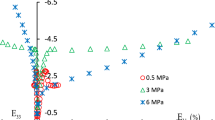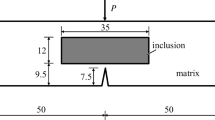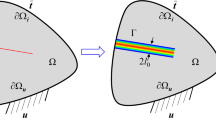Abstract
In the present research, a new criterion based on maximum shear stress (MSS) theory is developed for fracture investigation of orthotropic materials under mixed mode I/II loading. The crack is assumed to be embedded both along and across the fibers in the isotropic matrix. Self-similar crack propagation is assumed based on experimental observations and the reinforcement isotropic solid (RIS) concept is utilized for theoretical derivation of the criterion. In this model, an istropic crack tip stress field is assumed and the effects of fibers are supposed as stress reduction factors. The superiority of employing MSS theory in conjunction with RIS model is proved by derivation of a direct MSS-based mixed mode fracture criterion with respect to the orthotropic crack tip stress field. Verification of the results is performed by comparison of the fracture limit curves with available experimental mixed mode fracture data.




















Similar content being viewed by others
Abbreviations
- \(C_{ij} \) :
-
Components of compliance matrix
- \({C}'_{ij} \) :
-
Components of compliance matrix in plane strain condition
- \(C_{ij}^{{\text {off-axis}}} \) :
-
Off-axis components of compliance matrix
- \(C_{ij}^{{\text {on-axis}}} \) :
-
On-axis components of compliance matrix
- \(c_{t} ,c_{n} \) :
-
Extensional and sliding compliance of a damaged body
- \(E_{ij} \) :
-
Young’s modulus
- \(E_{L} ,E_{R} ,E_{T} \) :
-
Longitudinal, Radial and Tangential Young’s modulus for wood specimens
- \(f_{ij} (\theta ),g_{ij} (\theta )\) :
-
Angular functions
- \(G_{ij} \) :
-
Shear modulus of composite material
- \(K_{\mathrm{I}} ,K_{{\mathrm{II}}} \) :
-
Mode I and mode II stress intensity factors
- \(K_{{\mathrm{Ic}}} ,K_{{\mathrm{IIc}}} \) :
-
Mode I and mode II fracture toughness
- \(K_{\mathrm{I}}^{{\mathrm{kink}}} ,K_{{\mathrm{II}}}^{{\mathrm{kink}}} \) :
-
Mode I and mode II stress intensity factors at the tip of the crack kink
- L, R, T :
-
Longitudinal, Radial and Tangential orthotropy axes in wood specimen
- \(n_{i} \) :
-
Reinforcement factor
- r :
-
Distance from crack tip
- \(V_{f} ,V_{m} \) :
-
The volume fraction of fibers and the matrix in a composite
- x, y :
-
Global coordinate system
- \(\alpha _{ij} \) :
-
Related to crack kink angle
- \(\beta _{i}\) (i = 1...6):
-
Damage coefficient in the theoretical criteria
- \(\theta \) :
-
Arbitrary angle to show stress state in crack tip
- \(\lambda \) :
-
Dimensionless parameters
- \(\nu _{{\textit{LR}}} \) :
-
Poisson’s ratio in RL direction
- \(\nu _{{\textit{LT}}} \) :
-
Poisson’s ratio in TL direction
- \(\nu _{{\textit{TR}}} \) :
-
Poisson’s ratio in RT direction
- \(\xi _{i}\) (i = 1...3):
-
Reinforcement factor
- \(\rho _{i} \,\) :
-
Damage factor in fracture criteria
- \(\sigma _{ij}^{{\mathrm{iso}}} \) :
-
Isotropic stress tensor
- \(\sigma _{ij}^{{\mathrm{ortho}}} \) :
-
Orthotropic stress tensor
- \(\tau \) :
-
Shear stress
- \(\tau _{{\textit{cr}}} \) :
-
Critical Shear stress
- \(\varphi \) :
-
Crack-Fiber angle
- \(\chi \) :
-
Dimensionless parameters
- \(\psi \) :
-
Airy stress function
- ASER:
-
Augmented strain energy release rate
- EMSS:
-
Extended maximum shear stress
- FEM:
-
Finite element method
- MPS:
-
Maximum principal stress
- MSS:
-
Maximum shear stress
- MTS:
-
Maximum tangential stress
- RIS:
-
Reinforcement isotropic solid
- RIS–MSS:
-
Reinforcement isotropic solid–maximum shear stress criterion
- SED:
-
Strain energy density
- SER:
-
Strain energy release rate
- SIFs:
-
Stress intensity factors
References
Wang, Y.Q., et al.: Fracture analysis of superconducting composites with a sandwich structure based on electromagnetic-thermal coupled model. Acta Mech. 230(12), 4435–4451 (2019)
Daneshjoo, Z., Shokrieh, M.M., Fakoor, M.: A micromechanical model for prediction of mixed mode I/II delamination of laminated composites considering fiber bridging effects. Theor. Appl. Fract. Mech. 94, 46–56 (2018)
Chalivendra, Vijaya Bhaskar: Mixed-mode crack-tip stress fields for orthotropic functionally graded materials. Acta Mech. 204(1–2), 51–60 (2009)
Fakoor, Mahdi, Ghoreishi, Seyed Mohammad Navid: Verification of a micro-mechanical approach for the investigation of progressive damage in composite laminates. Acta Mech. 230(1), 225–241 (2019)
De Moura, M.F.S.F., Gonçalves, J.P.M., Silva, F.G.A.: A new energy based mixed-mode cohesive zone model. Int. J. Solids Struct. 102, 112–119 (2016)
Fakoor, Mahdi, Shahsavar, Sadra: Fracture assessment of cracked composite materials: progress in models and criteria. Theor. Appl. Fract. Mech. 105, 102430 (2020)
Wu, E.M.: Application of fracture mechanics to anisotropic plates. J. Appl. Mech. 34(4), 967–974 (1967)
McKinney, J.M.: Mixed-mode fracture of unidirectional graphite/epoxy composites. J. Compos. Mater. 6(1), 164–166 (1972)
Hunt, D.G., Croager, W.P.: Mode II fracture toughness of wood measured by a mixed-mode test method. J. Mater. Sci. Lett. 1(2), 77–79 (1982)
Mall, S., Murphy, Joseph F., Shottafer, James E.: Criterion for mixed mode fracture in wood. J. Eng. Mech. 109(3), 680–690 (1983)
Leicester, R.H.: Application of linear fracture mechanics to notched timber elements. Prog. Struct. Eng. Mater. 8(1), 29–37 (2006)
Theocaris, P.S.: The paraboloid failure surface for the general orthotropic material. Acta Mech. 79(1–2), 53–79 (1989)
Theocaris, P.S.: The elliptic paraboloid failure surface for 2D-transtropic plates (fiber laminates). Eng. Fract. Mech. 33(2), 185–203 (1989)
Theocaris, P.S.: The elliptic paraboloid failure criterion for cellular solids and brittle foams. Acta Mech. 89(1–4), 93–121 (1991)
Theocaris, P.S.: Failure criteria for weak-axis quasi-orthotropic woven fabric composites. Acta Mech. 95(1–4), 69–86 (1992)
Theocaris, P.S.: Failure criteria for transtropic, pressure dependent materials. Rheol. Acta 27(5), 451–465 (1988)
Tupholme, G.E.: A crack within a half-space of orthotropic elastic material. Acta Mech. 79(1–2), 143–152 (1989)
Bagheri, R., Malekzadeh Fard, K., Monfared, M.M.: Dynamic fracture analysis in an orthotropic half-plane with FGM coating containing several moving cracks. Acta Mech. 226(6), 1725–1736 (2015)
Matbuly, M.S., Nassar, M.: Elastostatic analysis of edge cracked orthotropic strips. Acta Mech. 165(1–2), 17–25 (2003)
Buczek, M.B., Herakovich, C.T.: A normal stress criterion for crack extension direction in orthotropic composite materials. J. Compos. Mater. 19(6), 544–553 (1985)
Jernkvist, Lars Olof: Fracture of wood under mixed mode loading: I. derivation of fracture criteria. Eng. Fract. Mech. 68(5), 549–563 (2001)
Jernkvist, Lars Olof: Fracture of wood under mixed mode loading: II. Experimental investigation of Picea abies. Eng. Fract. Mech. 68(5), 565–576 (2001)
Gdoutos, E.E., Zacharopoulos, D.A., Meletis, E.I.: Mixed-mode crack growth in anisotropic media. Eng. Fract. Mech. 34(2), 337–346 (1989)
Gdoutos, E.E.: Crack growth instability studied by the strain energy density theory. Arch. Appl. Mech. 82(10–11), 1361–1376 (2012)
Carloni, C., Nobile, L.: Crack initiation behaviour of orthotropic solids as predicted by the strain energy density theory. Theor. Appl. Fract. Mech. 38(2), 109–119 (2002)
Saouma, Victor E., Ayari, Mohamed L., Leavell, Daniel A.: Mixed mode crack propagation in homogeneous anisotropic solids. Eng. Fract. Mech. 27(2), 171–184 (1987)
Carloni, C., Nobile, L.: Maximum circumferential stress criterion applied to orthotropic materials. Fatigue Fract. Eng. Mater. Struct. 28(9), 825–833 (2005)
Fakoor, M., Rafiee, R.: Fracture investigation of wood under mixed mode I/II loading based on the maximum shear stress criterion. Strength Mater. 45(3), 378–385 (2013)
Romanowicz, Marek, Seweryn, Andrzej: Verification of a non-local stress criterion for mixed mode fracture in wood. Eng. Fract. Mech. 75(10), 3141–3160 (2008)
Romanowicz, Marek: A non-local stress fracture criterion accounting for the anisotropy of the fracture toughness. Eng. Fract. Mech. 214, 544–557 (2019)
Lu, Huaiyu, et al.: Progressive damage investigation of 2.5 D woven composites under quasi-static tension. Acta Mech. 230(4), 1323–1336 (2019)
Huynh, D.B.P., Belytschko, T.: The extended finite element method for fracture in composite materials. Int. J. Numer. Meth. Eng. 77(2), 214–239 (2009)
Ma, Zhichao, Zhao, Hongwei, Ren, Luquan: Fracture criterion on the basis of uniformity of plastic work of polycrystalline ductile materials under various stress states. Acta Mech. 227(7), 2053–2059 (2016)
Shindo, Y., Narita, F., Sato, T.: Analysis of mode II interlaminar fracture and damage behavior in end notched flexure testing of GFRP woven laminates at cryogenic temperatures. Acta Mech. 187(1–4), 231–240 (2006)
Anaraki, A.R.Gowhari, Fakoor, M.: A new mixed-mode fracture criterion for orthotropic materials, based on strength properties. J. Strain Anal. Eng. Des. 46(1), 33–44 (2011)
Fakoor, M., Mehri Khansari, N.: Mixed mode I/II fracture criterion for orthotropic materials based on damage zone properties. Eng. Fract. Mech. 153, 407–420 (2016)
Berto, F., Lazzarin, P.: A review of the volume-based strain energy density approach applied to V-notches and welded structures. Theor. Appl. Fract. Mech. 52(3), 183–194 (2009)
Gómez, F.J., Elices, M., Berto, F., Lazzarin, P.: Local strain energy to assess the static failure of U-notches in plates under mixed mode loading. Int. J. Fract. 145(1), 29–45 (2007)
Ayatollahi, M.R., Aliha, M.R.M.: Mixed mode fracture in soda lime glass analyzed by using the generalized MTS criterion. Int. J. Solids Struct. 46(2), 311–321 (2009)
Ayatollahi, M.R., Aliha, M.R.M.: Mixed mode fracture analysis of polycrystalline graphite-a modified MTS criterion. Carbon 46(10), 1302–1308 (2008)
Berto, F., Lazzarin, P.: Recent developments in brittle and quasi-brittle failure assessment of engineering materials by means of local approaches. Mater. Sci. Eng. R Rep. 75, 1–48 (2014)
Van der Put, T.A.C.M.: A new fracture mechanics theory for orthotropic materials like wood. Eng. Fract. Mech. 74(5), 771–781 (2007)
Anaraki, A.R.Gowhari, Fakoor, M.: Mixed mode fracture criterion for wood based on a reinforcement microcrack damage model. Mater. Sci. Eng. A 527(27–28), 7184–7191 (2010)
Fakoor, M.: Augmented strain energy release rate (ASER): a novel approach for investigation of mixed-mode I/II fracture of composite materials. Eng. Fract. Mech. 179, 177–189 (2017)
Fakoor, Mahdi, Shokrollahi, Maryam S.: A new macro-mechanical approach for investigation of damage zone effects on mixed mode I/II fracture of orthotropic materials. Acta Mech. 229(8), 3537–3556 (2018)
Fakoor, Mahdi, Khansari, Nabi Mehri: General mixed mode I/II failure criterion for composite materials based on matrix fracture properties. Theor. Appl. Fract. Mech. 96, 428–442 (2018)
Fakoor, Mahdi, Rafiee, Roham, Zare, Shahab: Equivalent reinforcement isotropic model for fracture investigation of orthotropic materials. Steel Compos. Struct. 30(1), 1–12 (2019)
Farid, Hannaneh Manafi, Fakoor, Mahdi: Mixed mode I/II fracture criterion for arbitrary cracks in orthotropic materials considering T-stress effects. Theor. Appl. Fract. Mech. 99, 147–160 (2019)
Fakoor, Mahdi, Farid, Hannaneh Manafi: Mixed-mode I/II fracture criterion for crack initiation assessment of composite materials. Acta Mech. 230(1), 281–301 (2019)
Khansari, Nabi Mehri, Fakoor, Mahdi, Berto, Filippo: Probabilistic micromechanical damage model for mixed mode I/II fracture investigation of composite materials. Theor. Appl. Fract. Mech. 99, 177–193 (2019)
Farid, Hannaneh Manafi, Fakoor, Mahdi: Mixed mode I/II fracture criterion to anticipate behavior of the orthotropic materials. Steel Compos. Struct. 34(5), 671 (2020)
De Moura, Marcelo F.S.F., Dourado, Nuno: Wood Fracture Characterization. CRC Press, Boca Raton (2018)
Ross, R.J.: Wood handbook: wood as an engineering material. USDA Forest Service, Forest Products Laboratory. General Technical Report FPL-GTR-190 509(5) (2010)
Sih, G., Co, P., Paris, C., Irwin, G.R.: On cracks in rectilinearly anisotropic bodies. Int. J. Fract. Mech. 1(3), 189–203 (1965)
Anaraki, A.R., Fakoor, M.: General mixed mode I/II fracture criterion for wood considering T-stress effects. Mater. Des. 31(9), 4461–4469 (2010)
Yang, S., Yuan, F.-G.: Kinked crack in anisotropic bodies. Int. J. Solids Struct. 37(45), 6635–6682 (2000)
Wang, Tzu-Chiang, Shih, C.Fong, Suo, Z.H.I.G.A.N.G.: Crack extension and kinking in laminates and bicrystals. Int. J Solids Struct. 29(3), 327–344 (1992)
Suo, Z., Bao, G., Fan, B., Wang, T.C.: Orthotropy rescaling and implications for fracture in composites. Int. J. Solids Struct. 28(2), 235–248 (1991)
Author information
Authors and Affiliations
Corresponding author
Additional information
Publisher's Note
Springer Nature remains neutral with regard to jurisdictional claims in published maps and institutional affiliations.
Rights and permissions
About this article
Cite this article
Shahsavar, S., Fakoor, M. & Berto, F. Verification of reinforcement isotropic solid model in conjunction with maximum shear stress criterion to anticipate mixed mode I/II fracture of composite materials. Acta Mech 231, 5105–5124 (2020). https://doi.org/10.1007/s00707-020-02810-8
Received:
Revised:
Accepted:
Published:
Issue Date:
DOI: https://doi.org/10.1007/s00707-020-02810-8




